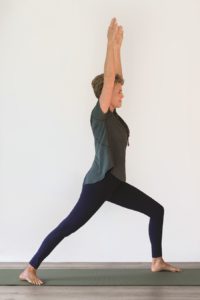In these times, it seems clear that we need courage and strength as well as a bit of fierceness to carry on. Maybe that is why the Warrior I pose is on my mind. In Sanskrit, it is known as Virabhadrasana I, named for a fierce mythical warrior from Hindu tradition. In this pose, you stand firm, grounded in the legs as you lift the chest and open the heart to whatever you are facing.
To get into the pose, you want to be standing on a firm surface where you can plant your feet and not worry about slipping. It doesn’t have to be a yoga mat — just not a slippery floor. Doing yoga on grass or at the beach is something a lot of people like.
Begin by standing with your feet hip-width apart and arms at your sides, extending down but relaxed. Take several deep, slow, and full breaths to help you relax and focus. Step the right foot forward, about the length of your leg. Keep your hips, pelvis, and upper body facing forward, so the top half of your body is pointed in the same direction as the toes of your right foot.

Now inhale and, as you do, raise your arms forward and up above your head as you bend the right knee so it lines up over the ankle. Press out through the back heel and turn the toes of the back foot forward — this can help with your balance. Both feet should be flat on the floor. If that is difficult, bring the back foot closer to the front one, or place a towel or wedge under your back heel to give it support.
Breathe. Now that you are in the pose, consider a few adjustments that will settle you into it more deeply.
First, pay attention to your core, the abdominal muscles that provide support and stability. Draw the muscles just below your belly button in and slightly up. Tuck your lower ribs in slightly; this helps connect the core and gives you better alignment in the pose. These are gentle movements, and you should still be able to breath easily.
From here, elongate your spine by lifting through the crown of your head and tucking the tailbone ever so slightly as you bring your attention to lifting the pubic bone.
Notice where your arms are. Keep them as far apart as they need to be to keep your elbows straight and shoulders open. Breathe and repeat the pose on the other side.
In yoga, we are always looking to open and keep space in the body wherever we can. There is a way in which this relates to strength. In daily life, most of us develop compensatory strategies for how to move our bodies, but these can end up causing compression and pain. We may recruit muscles from one part of the body to make up for the weak or tight muscles that we should actually be using to move efficiently and without strain. For example, if you have weak abdominal muscles, you may use your back muscles more to bend and twist and support the body. This can put too much stress on the back muscles, leading to pain.
When you assume a pose in yoga, the next step is to pay attention to what it is teaching you about your body. What part of the pose is difficult to do? Where do I have limitations? What is easy? Where do I feel strong?
When I first started to do Virabhadrasana I, I could not get my back heel on the floor, and it was hard for me to balance. For a long time, I did the pose with the heel up. My legs were not very strong, so I did not step my feet far apart. I tended to let my front knee drift in toward the center, which I learned puts strain on the knee joint. For a pose that looked so simple, there was always plenty to notice and shift.
Yet I grew to love this pose for all its strengthening and grounding qualities. Yoga is a great teacher of patience. Change will come.



